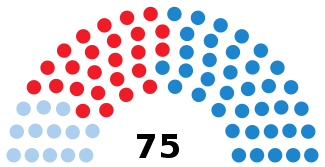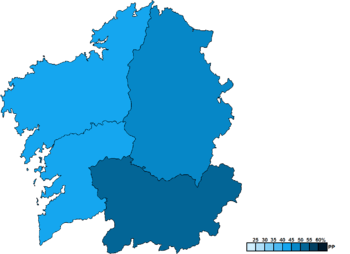Galician regional election, 2005
| |||||||||||||||||||||||||||||||||||||||||||||||||
All 75 seats in the Parliament of Galicia 38 seats needed for a majority | |||||||||||||||||||||||||||||||||||||||||||||||||
| Registered |
2,616,811 | ||||||||||||||||||||||||||||||||||||||||||||||||
| Turnout |
1,680,202 (64.2%) | ||||||||||||||||||||||||||||||||||||||||||||||||
| |||||||||||||||||||||||||||||||||||||||||||||||||
|
Constituency results map for the Parliament of Galicia | |||||||||||||||||||||||||||||||||||||||||||||||||
| |||||||||||||||||||||||||||||||||||||||||||||||||
The 2005 Galician regional election was held on Sunday, 19 June 2005, to elect the 7th Parliament of the Autonomous Community of Galicia. All 75 seats in the Parliament were up for election.
Electoral system
The Parliament of Galicia was the devolved, unicameral legislature of the autonomous community of Galicia, having legislative power in matters of regional competence as underlined by the Spanish Constitution and the Galician Statute of Autonomy, as well as the ability to grant or revoke confidence from a President of the Xunta.[1] Voting for the Parliament was on the basis of universal suffrage, with all nationals over eighteen, registered in Galicia and in full enjoyment of all political rights entitled to vote.
The 75 members of the Parliament of Galicia were elected using the D'Hondt method and a closed list proportional representation, with a threshold of 5 per 100 of valid votes—which included blank ballots—being applied in each constituency. Parties not reaching the threshold were not taken into consideration for seat distribution. Additionally, the use of the D'Hondt method might result in an effective threshold over five percent, dependant on the district magnitude.[2] Seats were allocated to constituencies, corresponding to the provinces of A Coruña, Lugo, Ourense and Pontevedra. Each constituency was entitled to an initial minimum of 10 seats, with the remaining 35 allocated among the constituencies in proportion to their populations.[3][1]
The electoral law provided that parties, federations, coalitions and groupings of electors were allowed to present lists of candidates. However, groupings of electors were required to secure at least the signature of 1 per 100 of the electors entered in electoral register of the constituency for which they were seeking election. Electors were barred from signing for more than one list of candidates. Concurrently, parties and federations intending to enter in coalition to take part jointly at an election were required to inform the relevant Electoral Commission within ten days from the election call.[3][4][5]
Election date
Article 11 of the Statute of Autonomy for Galicia of 1981 established that the term of the Parliament expired four years from the date of its previous election, unless it was dissolved earlier. Article 12 of the Parliament of Galicia Elections Law of 1985 required for the election Decree to be issued no later than the twenty-fifth day prior to the date of expiry of the Parliament in the event that the President did not make use of his prerogative of early dissolution. The Decree was to be published on the following day in the Official Journal of Galicia, with election day taking place between the fifty-fourth and the sixtieth day from publication. The previous election was held on 21 October 2001, which meant that the legislature's term would expire on 21 October 2005. The election Decree was required to be published no later than 27 September 2005, with the election taking place on the sixtieth day from publication, setting the latest possible election date for the Parliament at Saturday, 26 November 2005.[1][3]
Article 24 of the Xunta and President Law of 1983 granted the President the prerogative to dissolve the Parliament at any given time and call a snap election, provided that it did not occur before one year had elapsed since a previous dissolution under this procedure. Additionally, under Article 17 of the Law the Parliament was to be dissolved and a new election called if an investiture process failed to elect a regional President within a two-month period from the first ballot.[6]
Results
Overall
 | ||||||
| Parties and coalitions | Popular vote | Seats | ||||
|---|---|---|---|---|---|---|
| Votes | % | ±pp | Won | +/− | ||
| People's Party (PP) | 756,562 | 45.23 | –6.39 | 37 | –4 | |
| Socialists' Party of Galicia (PSdeG–PSOE) | 555,603 | 33.22 | +11.39 | 25 | +8 | |
| Galician Nationalist Bloc (BNG) | 311,954 | 18.65 | –3.93 | 13 | –4 | |
| Parties with less than 1.0% of the vote | 27,525 | 1.65 | — | 0 | ±0 | |
|---|---|---|---|---|---|---|
| United Left (EU–IU) | 12,419 | 0.74 | +0.06 | 0 | ±0 | |
| Galician People's Front (FPG) | 2,982 | 0.18 | –0.03 | 0 | ±0 | |
| Party of Self-employed and Professionals (AUTONOMO) | 2,840 | 0.17 | –0.12 | 0 | ±0 | |
| Democratic and Social Centre (CDS) | 2,412 | 0.14 | New | 0 | ±0 | |
| We–People's Unity (Nós–UP) | 1,749 | 0.10 | New | 0 | ±0 | |
| Humanist Party (PH) | 1,429 | 0.09 | –0.18 | 0 | ±0 | |
| Spanish Falange of the JONS (FE–JONS) | 1,081 | 0.06 | New | 0 | ±0 | |
| Ourensan Democracy (DO) | 623 | 0.04 | New | 0 | ±0 | |
| National Democracy (DN) | 550 | 0.03 | New | 0 | ±0 | |
| People's Spanish Social Party (PSEP) | 420 | 0.03 | New | 0 | ±0 | |
| Republican Left–Galician Republican Left (IR–ERG) | 405 | 0.02 | New | 0 | ±0 | |
| Galician Identity (IG) | 376 | 0.02 | New | 0 | ±0 | |
| Social Democratic Party of Law (SDD) | 239 | 0.01 | –0.03 | 0 | ±0 | |
| Blank ballots | 20,912 | 1.25 | –0.44 | |||||||
| Total | 1,672,556 | 100.00 | 75 | ±0 | ||||||
| Valid votes | 1,672,556 | 99.54 | +0.24 | |||||||
| Invalid votes | 7,646 | 0.46 | –0.24 | |||||||
| Votes cast / turnout | 1,680,202 | 64.21 | +4.05 | |||||||
| Abstentions | 936,609 | 35.79 | –4.05 | |||||||
| Registered voters | 2,616,811 | |||||||||
| Source(s): Argos Information Portal, historiaelectoral.com | ||||||||||
Distribution by constituency
| Constituency | PP | PSdeG | BNG | |||
|---|---|---|---|---|---|---|
| % | S | % | S | % | S | |
| A Coruña | 42.9 | 11 | 33.2 | 8 | 20.5 | 5 |
| Lugo | 48.9 | 8 | 34.5 | 5 | 14.5 | 2 |
| Ourense | 50.8 | 8 | 30.9 | 4 | 16.3 | 2 |
| Pontevedra | 44.1 | 10 | 33.6 | 8 | 19.2 | 4 |
| Total | 45.2 | 37 | 33.2 | 25 | 18.7 | 13 |
Aftermath
Investiture vote
| Candidate: Emilio Pérez Touriño | |||
|---|---|---|---|
| Choice | Vote | ||
| Parties | Votes | ||
| |
PSdeG–PSOE (25), BNG (13) | 38 / 75 | |
| No | PP (37) | 37 / 75 | |
| Abstentions | 0 / 75 | ||
| Source: historiaelectoral.com | |||
References
- 1 2 3 Statute of Autonomy for Galicia of 1981, Organic Law No. 1 of April 6, 1981 Official State Gazette (in Spanish). Retrieved on 8 August 2017.
- ↑ "Effective threshold in electoral systems". Trinity College, Dublin. 30 July 2012. Retrieved 22 July 2017.
- 1 2 3 Parliament of Galicia Elections Law of 1985, Law No. 2 of August 13, 1985 Official Journal of Galicia (in Spanish). Retrieved on 8 August 2017.
- ↑ General Electoral System Organic Law of 1985, Organic Law No. 5 of June 19, 1985 Official State Gazette (in Spanish). Retrieved on 28 December 2016.
- ↑ "Representation of the people Institutional Act". juntaelectoralcentral.es. Central Electoral Commission. Retrieved 16 June 2017.
- ↑ Xunta and President Law of 1983, Law No. 1 of February 22, 1983 Official Journal of Galicia (in Spanish). Retrieved on 8 August 2017.
.jpg)
.jpg)
.jpg)
